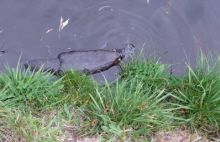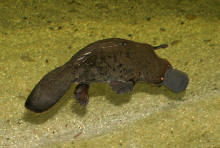The Platypus
The Platypus is the New South Wales Animal Emblem
Along with the Echidna they are the only existing species of monotreme (mammals that lay eggs).
They have a streamlined body, webbed feet, a broad tail and a bill that resembles a duck's bill but is actually a snout covered with soft, moist, leathery skin and sensitive nerve endings.
They measure about 30 to 45 centimetres in length, their weight varies quite a lot from 700 grams to 2.4 kilograms, with the males being bigger than the females.
The male has ankle spurs which produce a venom that is strong enough to kill smaller animals but not lethal to humans, but is, apparently, still very painful.
Monotremes are the only mammals known to have a sense of electroreception, which is the ability to receive and make use of electrical impulses, they locate their prey partly by detecting electric fields generated by muscular contractions. The Australian Platypus' electroreception is the most sensitive of any monotreme.
They also have excellent eyesight and hearing, with a range of hearing similar to the frequencies that humans can detect, but with the ability to hear lower frequencies than us.
They are also excellent swimmers and spend a great deal of time in the water looking for food, they move themselves, when swimming, with a rowing motion using their two front feet alternatively, the hind feet are not used in this propulsion but are used for steering, in combination with their tail.
They spend around half their days at rest in their burrows that they dig into banks around rivers, lakes or streams, they normally leave their burrows around dusk, and spend their nights foraging, returning to their burrows around dawn.

They eat small invertebrate animals, including crustaceans, worms and molluscs, as well as the larvae of many freshwater insects, which they dive and search for in shallow waters
They are solitary Australian animals that usually only get together to mate, which happens once a year, in the northern areas where they are found, this is in late June, in the southern areas it is in October.
The Female usually lays two eggs about 21 days after mating, which she incubates between her belly and her tail by holding them; they hatch after about 10 days.
Like the Echidna, they don't have nipples, the milk oozes through the skin along both sides of the mother's belly.
The young is called a puggle and is weaned at about four months.
The Australian Platypus is featured on our 20 cent coin.
They are found in the eastern states of Australia, from north Queensland to Tasmania, mainly east of the Great Dividing Range.
They live in a wide range of habitats and climates, from tropical rainforests to alpine lakes.
They are a protected species in Australia.
The Platypus was proclaimed the New South Wales
Animal Emblem in 1971
Banjo Paterson wrote a wonderful poem about this unique Aussie animal.
Old Man Platypus
Far from the trouble and toil of town,
Where the reed beds sweep and shiver,
Look at a fragment of velvet brown-
Old Man Platypus drifting down,
Drifting along the river.
And he plays and dives in the river bends
In a style that is most elusive;
With few relations and fewer friends,
For Old Man Platypus descends
From a family most exclusive.
He shares his burrow beneath the bank
With his wife and his son and daughter
At the roots of the reeds and the grasses rank;
And the bubbles show where our hero sank
To its entrance under water.
Safe in their burrow below the falls
They live in a world of wonder,
Where no one visits and no one calls,
They sleep like little brown billiard balls
With their beaks tucked neatly under.
And he talks in a deep unfriendly growl
As he goes on his journey lonely;
For he's no relation to fish nor fowl,
Nor to bird nor beast, nor to horned owl;
In fact, he's the one and only!
A. B. (Banjo) Paterson
Go to next animal page: Leadbeaters Possum
Return to Australian Animals or Australian Animal Emblems
Return from Platypus to Australian-Information-Stories home page



